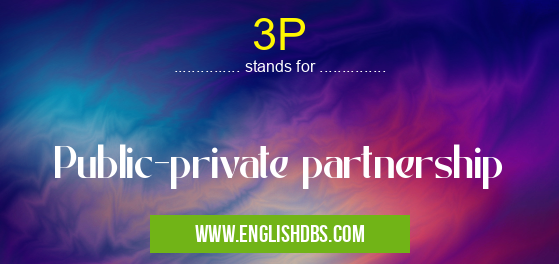What does 3P mean in FINANCE
3P (Public-Private Partnership) is a collaborative venture between the public sector (government) and the private sector (businesses or non-profit organizations). It involves the government outsourcing specific projects or services to the private sector while maintaining some level of control and involvement.

3P meaning in Finance in Business
3P mostly used in an acronym Finance in Category Business that means Public-private partnership
Shorthand: 3P,
Full Form: Public-private partnership
For more information of "Public-private partnership", see the section below.
Characteristics of 3P
- Shared Risk and Reward: Both the public and private sectors share the risks and rewards associated with the project.
- Long-Term Contracts: 3P contracts are typically long-term (10 years or more) to allow for project development, implementation, and ongoing management.
- Shared Governance: The private sector is responsible for project delivery, while the government retains oversight and decision-making authority.
Benefits of 3P
- Access to Private Sector Expertise: 3P leverages the specialized skills and resources of the private sector for project implementation.
- Reduced Public Debt: By privatizing certain projects, governments can lower public debt and free up funds for other priorities.
- Improved Efficiency and Innovation: Private sector partners often bring more efficient and innovative solutions to project delivery.
Challenges of 3P
- Contract Management Complexity: 3P contracts are complex and require careful management to ensure both public and private interests are met.
- Cost Overruns: Private sector partners may face cost overruns or unexpected expenses, which can impact project viability.
- Public Scrutiny: 3P projects can be subject to public scrutiny and criticism, especially if they are perceived as benefiting the private sector at the expense of the public.
Essential Questions and Answers on Public-private partnership in "BUSINESS»FINANCE"
What is a public-private partnership (PPP)?
A PPP is a long-term contract between a government agency and a private-sector company to finance, design, build, and/or operate a public infrastructure project or service.
What are the benefits of PPPs?
PPPs can provide several benefits, including:
- Increased efficiency and cost-effectiveness
- Access to private-sector expertise and innovation
- Risk sharing between the public and private sectors
- Improved project quality and completion timelines
- Economic development and job creation
What are the risks of PPPs?
While PPPs can offer significant benefits, there are also potential risks to consider, such as:
- Complexity and cost of negotiation and implementation
- Potential for conflict between public and private interests
- Limited public control and accountability
- Risk of project failure or cost overruns
What are some examples of PPPs?
Examples of PPPs include:
- Infrastructure projects: roads, bridges, airports, public transportation
- Public facilities: hospitals, schools, libraries
- Social services: healthcare, childcare, education
How are PPPs structured?
PPPs can vary in structure, but typically involve the following elements:
- A long-term contract (typically 20-30 years)
- A division of responsibilities between the public and private partners
- Performance-based payments to the private partner
- Risk allocation mechanisms
How are PPPs evaluated?
PPPs are evaluated based on a variety of factors, including:
- Cost-effectiveness
- Project quality and performance
- Risk management
- Public benefit and impact
- Overall value for money
Final Words: 3P is a complex but potentially beneficial collaboration model that can leverage the strengths of both the public and private sectors. By carefully managing risks and ensuring transparency, 3P projects can contribute to project success and improve service delivery. However, it is essential to consider the potential challenges and ensure that 3P agreements are structured to align with the public interest.
3P also stands for: |
|
| All stands for 3P |
